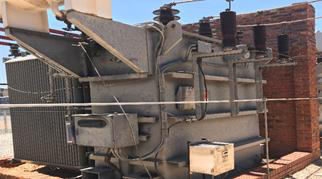Client Background
Transformer oil tests including Dissolved Gas Analysis (DGA) were conducted on the oil filled transformers at Nampak Glass, Germiston, during November 2016.
The diagnostic analysis of the oil sample reports indicated that a number of the units were found to have excessive moisture within the insulation, causing low dielectric strength of the insulating fluid.
This condition is undesirable as it not only compromises the integrity of the insulation, but also impacts long term reliability and return on investment by accelerated ageing.
After reviewing the previous annual oil sample reports, it was felt that the technique that was used in the past to take periodic oil samples from transformers to monitor and manage dryout processes may have some shortfalls.
Key Challenges
Implement correct oil sample process
The evaluation of moisture in paper is very dependent on capturing the top oil temperature of the unit at the time of taking the sample and the technique with which the sample is taken. Incorrectly taken sample material can lead to incorrect results.
Technical Capabilities of Oil Diagnostic
Internationally recognised calculation methods must be used during the diagnostic phase to determine the most appropriate action plans to manage the fleet risk and plan
corrective dry outs. The criticality and lab results must be taken into account during the planning phase.
Dry-out methods
It was noted that the numerous previous interventions had little or very low impact on the amount of moisture that was calculated using internationally recognised methods.
Martec Intervention
- Transformer oil samples were taken with oil syringes that ensure quality and cleanliness of the sample. This is important as it maintains the integrity of the sample before the analysis.
- A technical oil specialist conducted the diagnostic of the sample transformer oil reports.
- The specialist used the oil report findings to calculate and programme the Expiotech dryout filter unit to run until acceptable levels are maintained.
- The advanced unique filtration technology was implemented under Martec quality assurance processes according to international standards. The dry-out process was managed 24/7 with online remote monitoring technology.
- On completion, Martec fitted a permanent monitoring system on a critical furnace transformer. The last data taken in March 2018 indicated early signs of a developing fault condition that is now under investigation.
- The savings projected for Nampak will be used to extend the life of the existing transformers until 2020 by implementing permanent online monitors.
Value add
- Previous dry-out processes using heat vacuum had very little or low impact, therefore the improved process method is to filter the transformer oil during normal operation.
- The elevated temperature of the in-service transformer is used to drive the moisture out of the insulation system and into the oil, from where it is extracted.
- The process will be monitored 24/7 off site (remote online monitoring).
- The process to remove the moisture from the transformers is programmed to run until acceptable dry-out levels are maintained as calculated from the moisture-in-oil analysis.

Tools and technology
- The Expiotech technology is a unique filtration method used during the dry-out process.
- Online permanent oil monitoring technology was implemented on one of the critical furnace transformers.
- The permanent monitoring technology provides 24/7 early warning and defect detection, permitting the transformer to be nursed until replacement becomes possible.